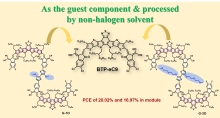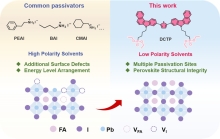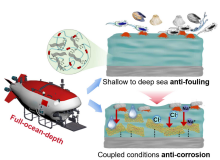 12/09/2025
12/09/2025Novel Giant Acceptor Boost Non-Halogenated-Processed Organic Solar Cell Efficiency
A research group led by Prof. GE Ziyi from the Ningbo Institute of Materials Technology and Engineering (NIMTE) of the Chinese Academy of Sciences (CAS) has developed novel giant acceptors with an oxygenated linker, achieving highly efficient non-halogenated-processed organic solar cells (OSCs) with a power conversion efficiency (PCE) up to 20.02%. This work was published in...
 11/04/2025Scientists Develop Low-Polarity Solvent-Soluble Passivator for Efficient and Stable Perovskite Solar Cells
11/04/2025Scientists Develop Low-Polarity Solvent-Soluble Passivator for Efficient and Stable Perovskite Solar Cells
A research group led by Prof. GE Ziyi from the Ningbo Institute of Materials Technology and Engineering (NIMTE) of the Chinese Academy of Sciences (CAS), in collaboration with Prof. QU Bo from Peking University, has developed a novel passivator soluble in low-polarity solvents, achieving a highly stable perovskite solar cell (PSC) with a power conversion efficiency (PCE) up ...
 10/31/2025Cage-Like Molecule Unlocks High Efficiency and Stability in Tandem Solar Cells
10/31/2025Cage-Like Molecule Unlocks High Efficiency and Stability in Tandem Solar Cells
Prof. YE Jichun’s team from the Ningbo Institute of Materials Technology and Engineering (NIMTE) of the Chinese Academy of Sciences (CAS) has developed a novel multifunctional cage-like diammonium chloride molecule. This molecule effectively minimizes interfacial energy losses, enabling the resulting perovskite/silicon tandem solar cells (TSCs) to achieve excellent efficien...
 10/28/2025Scientists Develop Full-Ocean-Depth-Oriented Integrated Antifouling/Anticorrosion Coating
10/28/2025Scientists Develop Full-Ocean-Depth-Oriented Integrated Antifouling/Anticorrosion Coating
The State Key Laboratory of Advanced Marine Materials at the Ningbo Institute of Materials Technology and Engineering (NIMTE) of the Chinese Academy of Sciences (CAS) has developed a novel full-ocean-depth-oriented integrated Poly(oxime-urethane) coating, delivering impressive anti-fouling/anti-corrosion performance for marine applications.
The study was published in ACS Nano.
 09/02/2025Scientists Decode Water's Key Role in Platinum-Catalyzed Biomass Conversion
09/02/2025Scientists Decode Water's Key Role in Platinum-Catalyzed Biomass Conversion
Chinese scientists have uncovered the crucial atomic-scale mechanism behind water's remarkable ability to boost platinum (Pt)-catalyzed biomass conversion, according to a recent research article published in the Journal of the American Chemical Society.